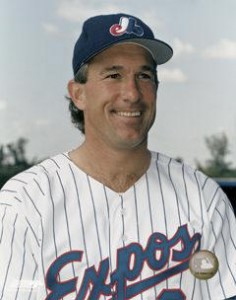
Joel Peralta tips his cap in mock respect after getting tossed for having "an excess of pine tar" in his glove. Photo Patrick McDermott/Getty Images via bleacherreport
While watching the Nats game tonight, the broadcast team of Bob Carpenter and JP Santangelo posted the following quote (as referenced in several of the beat reporters columns earlier today):
“Just looking down the road, if I’m a major league player that may happen to want to come to play for the Nationals in the future, I might think twice about it, under the circumstances,” Maddon said before Wednesday’s game. “Because this is a guy, this is one of their former children here that had really performed well and all of sudden he’s going to come back to this town and they’re going to rat on him based on some insider information.”
The MASN broadcast team also relayed a follow-up to this quote, mentioning that a beat reporter that they had not “seen before” asked Joe Maddon a very probing, intelligent question. As transcribed from the MASN broadcast:
“Well, your guy was the one who was caught. A lot of people are talking about the fact that you’re trying to deflect the blame to the to the other team across the diamond.”
Maddon apparently blew off the question, didn’t ask it and challenged the questioner whether or not he covered baseball on a regular basis. These quotes somewhat disappointed me; I have a lot of respect for Maddon by virtue of stories about him in Jonah Keri‘s excellent book “The Extra 2%,” about the rise of Tampa Bay. Perhaps he’s indeed trying to deflect blame and control the story. But I think Maddon does the exact same thing, if he’s in the same situation.
Last night’s gamesmanship was probably unnecessary, but a move that you have to make in the right situation. Yes the Nats probably were aware of the fact that Peralta had a tendency to overdo the pine tar, by virtue of his playing for our team a couple years ago. Was last night an odd time to cash in that particular chip? The team was losing, but the game was close, and Peralta is clearly a great asset out of the Rays bullpen. In fact, it surprised me to see the team not pursue signing Peralta after his excellent 2010 season for us.
Perhaps the message was meant more for Peralta; who knows what type of departure he had from the team. But you would have to think that if the team still respected him as a player, instead of trying to get him ejected perhaps Davey Johnson would have taken the same route that Tony LaRussa did in the 2006 world series, when hurler Kenny Rogers clearly had pine tar all over his throwing hand, a fact that became clear when the high definition cameras caught him throwing in the first inning.
The fact is, when its hot out and you’re sweating, getting a grip on the baseball can be very difficult. I certainly use pine tar heavily when I play to get an extra grip on the bat. I have certainly played with pitchers who had a secret stash of pine tar “hidden” within their glove in order to get an extra snap on the curve. Is this a violation of baseball’s rules? Of course it’s against the stated rules. The question is whether it is as egregious a transgression as (say) stealing signs or sneaking a peak at the catcher’s signs.
Much like a football player moving teams and taking along insider information on formations and trade secrets, inside information either brought to or left with teams can put managers in a tough situation. Billy Martin was well aware of George Brett‘s proclivity to over-tar his bat, and he waited until a key game situation (i.e., a go-ahead homer) to cash in that particular chip. Clearly Johnson made the decision to use the information he had on hand, last night in a key late-inning situation.
What do you guys think? Bush league move? Good use of information?
